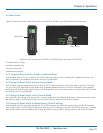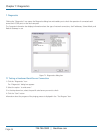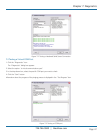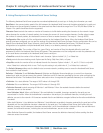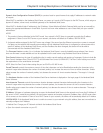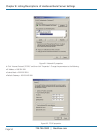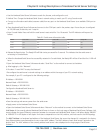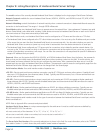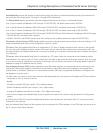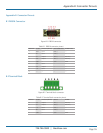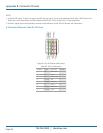
724-746-5500 | blackbox.com
724-746-5500 | blackbox.com
Page 53
Chapter 8: Listing/Descriptions of Hardened Serial Server Settings
Serial Watchdog controls the duration of serial inactivity when the serial port is determined idle and causes all connections for
that serial port to be forced closed. The range is 1 through 65535 milliseconds.
The Subnet Mask specifies the network mask the Hardened Serial Server uses when on a subnetted network.
• For a Class A network (IP addresses 0.0.0.0 through 127.255.255.255), the default subnet mask is 255.0.0.0.
• For a Class B network (IP addresses 128.0.0.0 through 191.255.255.255), the default subnet mask is 255.255.0.0.
• For a Class C network (IP addresses 192.0.0.0 through 233.255.255.255), the default subnet mask is 255.255.255.0.
• For a Class D network (IP addresses 224.0.0.0 through 239.255.255.255) and Class E Networks (IP addresses 240.0.0.0 through
255.255.255.255), the subnet mask is ignored.
• LES421A, LES422A, and LES424A servers come from the factory with a default subnet mask value of: 255.255.255.0.
Transmission Control Protocol (TCP) provides reliable connection-oriented network communication with error checking. In TCP
mode the Hardened Serial Server can be configured as a client or a server.
TCP client. When the Hardened Serial Server is configured as a TCP client, it initiates connections with a server on the network.
You must set up the IP address and port number of the server that you want the client (serial server) to communicate with. You
also select whether the Hardened Serial Server is to connect at power up or only when it receives data from the device connected
to its serial port.
TCP server. When the Hardened Serial Server is configured as a TCP server it waits for connections to be initiated by another
network device. You must set up the TCP port number that it will listen to for connections and set the maximum (one, up to two,
or up to four) number of simultaneous connections it will accept. You can filter the connections it will accept based on specific IP
addresses or ranges of IP addresses that you specify.
User Datagram Protocol (UDP) enables applications using UDP socket programs to communicate with the serial ports on the
serial server. UDP protocol provides connectionless communications, which allows data to be broadcast to and received from
multiple nodes on a network. (Because it is a connectionless protocol, UDP does not guarantee the delivery of a datagram and
the datagram is only sent once.)
• In UDP mode, if you want to control what network node receives data, you must specify the IP address and UDP port the data
will be sent to. You can choose to send to:
- Nobody
- All nodes at a specific UDP port number. (This is called broadcast.)
- Specific IP addresses and UDP port numbers. (This is called unicast.)
- A range of IP addresses and UDP port numbers. (This is called unicast range.)
• You can also configure the Hardened Serial Server to receive from nodes on the network using the same list of configuration
options.
In VCOM (Virtual COM Port) mode the Hardened Serial Server communicates over the network with a PC, acting as a remote
COM port for the computer.
Both the Hardened Serial Server and the computer must be configured for VCOM operation. Virtual COM ports can be set up on
the PC using the Serial Server Software.



